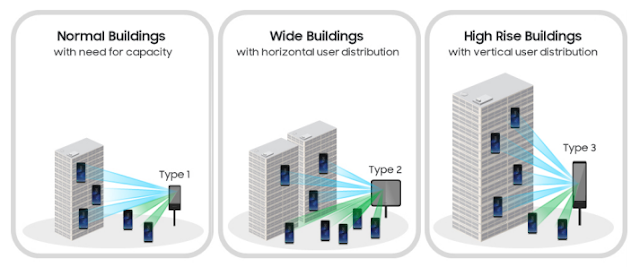
An active antenna is an antenna that contains active electronic components like antenna-integrated radio designs place the RF module next to the passive antenna to reduce cable losses.
Active Antenna does not need to be merely passive elements. With intelligent integration, active antenna technology transforms traditional antenna to contribute to base station efficiency. This enables operators to significantly increase the capacity and coverage targets set for their network.
As a base station system evolved, the AAS integrated the active transceiver array and the passive antenna array into one radome.
In normal mode, RRH is connected to Antenna through RF cable. So there are two different units (one is RRH and second is antenna) , on the other hand, AAS is altogether single unit where different antenna elements has their own RF transceiver chains integrated.
AAS is integrated into the antenna so as to offer possibilities for finer grained digital control of the beamforming weight of each individual subelement within the antenna.
 |
| 2D Vs 3D Antenna |
AAS are introduced with 16 ports antenna (8 beams), before it we talk about passive 2D antenna. Its 3D-MIMO technologies fully utilize radio resources in both the micro- and macro-spatial domains.
3D Aspect of AAS
Traditionally and still, evaluations in the wireless communication field use channel models with only two dimensions, even though we live in a three-dimensional world. The vertical direction is basically non-existent in these models, all UEs are assumed to be placed on ground-level.
UE specific elevation beamforming is one key technique that we are exploring in the context of 3D channel models. It allows a beam to be directed in a way that suits each individual UE in the cell. For example, a UE high up in a high-rise may desire a beam pointing upwards, while a UE on the ground level may get a downwards pointing beam.
MU-MIMO
The term MIMO usually refers to Single User MIMO (SU-MIMO). In Single User MIMO, both the base station and UE have multiple antenna ports and antennas, and multiple data streams are transmitted simultaneously to the UE using same time/frequency resources, doubling (2×2 MIMO), or quadrupling (4×4 MIMO) the peak throughput of a single user.
In MU-MIMO, base station sends multiple data streams, one per UE, using the same time-frequency resources. Hence, MU-MIMO increases the total cell throughput, i.e. cell capacity. The base station has multiple antenna ports, as many as there are UEs receiving data simultaneously, and one antenna port is needed in each UE.
The performance potential of beamforming techniques tends to increase with an increasing number of antennas, since the baseband gets access to more degrees of spatial freedom. This is facilitated by techniques for active antenna systems (AAS) where the radio is integrated into the antenna so as to offer possibilities for finer grained digital control of the beamforming weight of each individual subelement within the antenna.
AAS for 5G
Massive MIMO is the back-bone for 5G network where 100 or more antenna elements are to be used for various benefits. But it is difficult to introduce massive-elements antennas (100 or more elements) that are required for massive MIMO into traditional base stations, attaching over 100 RF cables between each antenna element and RF TRX unit seems unrealistic and adding more RF losses. Using an AAS that combines the antennas, and RF TRX unit (transmitter and receiver chains), into one unit would be an effective way to resolve these issues.
In addition to the conventional roof top mounting locations, small cells are expected to cover shopping malls, Stadiums, food canteens, or different premises. To be effective, AAS/MIMO must be able to flexibly adapt to each individual small cell user’s distribution environment, so optimum antenna structure can be offered for any individual situation in terms of the number of vertical and horizontal antenna elements and the number of independent transceivers, adding huge efficiency to the network.
AAS BENEFITS
• Improved spectral efficiency and network capacity for higher throughput. The system sends and receives multiple data signals over the same radio channel, which increases the spectral efficiency per cell and the number of users who can be served simultaneously. This raises the peak and average cell throughput more cost-effectively than other techniques, such as new spectrum or additional sites.
• Stronger signal and reduction of interference for better coverage. Beamforming provides accurate and
narrow beams through aiming of the signal, which reduces interference and improves signal quality,
especially at the cell edge. Beamforming allows for expanded reach of the cell compared to traditional
antennas. This is particularly true for higher frequencies where beamforming compensates for the higher path loss.
23:30
Tags :
5G NR
,
AAS
,
AAU
,
Antenna
,
Beamforming
,
LTE
,
Massive_Mimo
,
MU_MIMO
Subscribe by Email
Follow Updates Articles from This Blog via Email






No Comments